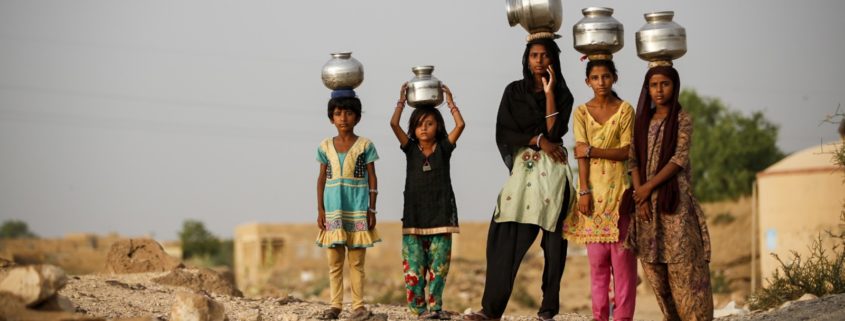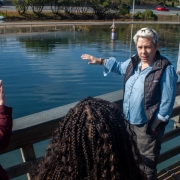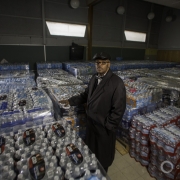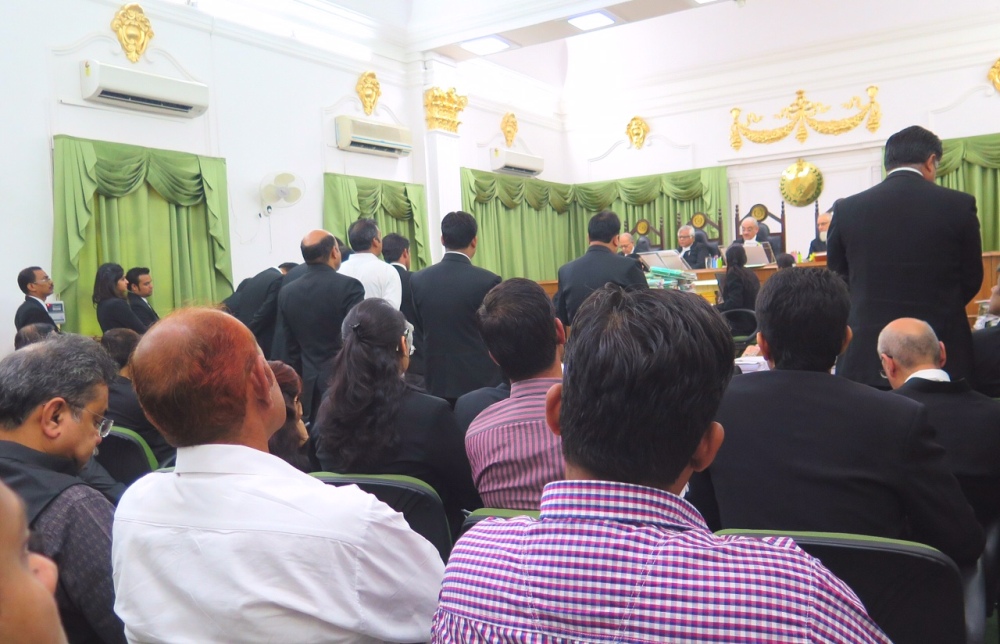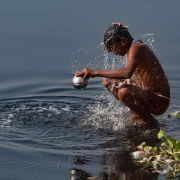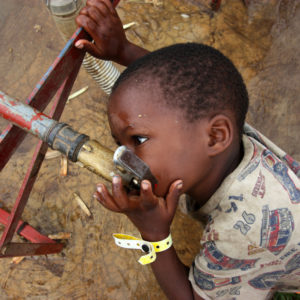UN Prepares First Evaluation of Higher Standard for Water and Sanitation
Clean water for all, a sustainable development goal, will be much harder to achieve than past targets.
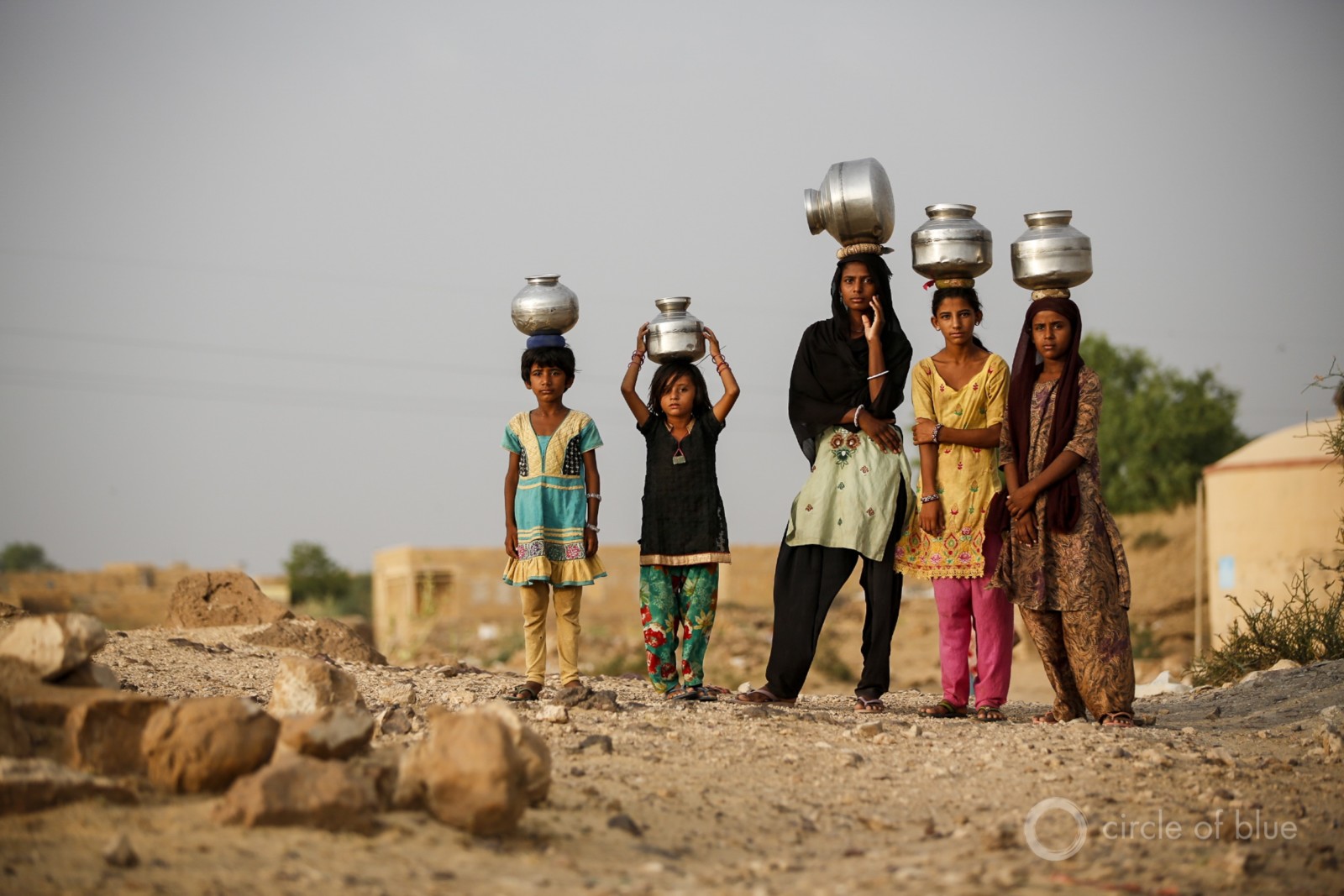
Girls in Jaisalmer, a city in the Indian state of Rajasthan, hold water jars on their heads. The United Nations sustainable development goals prioritize water for all and an end to long walks to collect water. Photo © J. Carl Ganter / Circle of Blue
By Brett Walton, Circle of Blue
When they adopted, in September 2015, a new global agenda for eliminating poverty, the member countries of the United Nations raised the bar for drinking water and sanitation.
The sustainable development goals, or SDGs, moved beyond the half-measures of the UN’s earlier poverty plan. Instead of focusing just on hardware — wells, pipes, toilets, and the like — the SDGs established ambitious economic, social, and environmental priorities that encompass the entire water management cycle, from river basin to tap: Clean water for everyone, and sanitation for all.
Easier announced than accomplished, for sure. But every journey has a start line, and for the water and sanitation SDG, that start line, at least statistically, comes on July 13.
On that date, a monitoring program run by the World Health Organization and UNICEF will release the first drinking water and sanitation assessment report under the SDGs. The report will provide baseline statistics against which the world will measure progress toward the ambitious agenda that its leaders have put forward.
Because of the more rigorous benchmarks of success represented by the SDGs, this initial assessment may have humbling conclusions, said Catarina Fonseca, head of the international and innovation program at IRC WASH, a leading water and sanitation organization. Countries that met the MDGs, the earlier UN poverty plan that the SDGs replaced, may fall short of the higher standards.
“It will give a very different picture for the water sector, for the worse,” Fonseca told Circle of Blue. “I don’t think it will look good, but I’m curious to see.”
New Definition of Success
The MDGs, in essence, evaluated drinking water and toilet facilities, not the quality of the water that was coming into the taps or being discharged into rivers. The core definition was “improved source,” which measured the construction style of toilets or water systems. Covered wells, which prevent contamination, are improved. Tanker trucks are not. Flush toilets, septic tanks, and composting toilets, likewise, are improved. An open-pit latrine is not.
The MDG goal was to halve to proportion of people using an unimproved source by 2015. The world, collectively, met that target for drinking water, but not for sanitation. Many countries and regions, especially in sub-Saharan Africa, are still far behind. Some 663 million people still use unimproved drinking water sources and 2.4 billion use unimproved sanitation, according to the WHO/UNICEF monitoring program.
The SDGs expand and build upon the improved/unimproved definition. The key phrase now is “safely managed,” which has three components that measure accessibility, availability, and pollution. To meet this standard, drinking water should be acquired from an improved source located within the household property, available when needed, and free from fecal bacteria as well as arsenic and fluoride, the two chemical contaminants identified as priorities.
For sanitation, safely managed means the use of an improved facility in which the toilet waste is disposed of, either on-site or treated at an outside unit, and a handwashing station with soap available.
Safely managed is a “new rung at the top of the ladder,” said Tom Slaymaker, a statistics and monitoring specialist at UNICEF who helps compile the report. Lower rungs — called “basic” and “limited” — denote an improved water source in which the time to walk and collect water is either less than or greater than 30 minutes.
The rungs were developed in a series of consultations between UN officials, water organizations, and government representatives. Fonseca, whose organization pushed for the stricter standards, said that changes in thinking, radical changes in some cases, are required to meet the SDGs for water. She drew a comparison to the operation of health, education, and energy systems.
“These are complex systems,” she explained. “They are not just about the schools or the teacher or the doctors or the electrical poles. It’s a whole complex system of institutions, finance, regulation. And the change that is needed is that agencies working in the water sector need to move from looking at the sector as an infrastructure — as pipes and pumps — and actually look at it as a complex system.”
Agencies, Fonseca said, means not only aid groups and donor countries. Support from national governments will be essential if the world is to even come close to the water-for-all goal.
At current rates, one-third of countries will not achieve universal access to an improved source by 2030, the end of the SDG evaluation period.
Measurement Results in Action
The SDG definition presents a number of statistical challenges, Slaymaker told Circle of Blue. For many countries the data simply are not available. Slaymaker said that the report will have baseline estimates of safely managed drinking water and sanitation for roughly half of countries.
A second issue is the quality of the data, all of which comes from national government agencies. Countries use slightly different definitions that need to be harmonized, Slaymaker said. Some have only urban data and others test water quality infrequently. “The data is only as good as the checks available at the national level,” he said.
The report is not an idle exercise. The data it presents influence the flow of money and resources.
“Accurate measurement allows us to improve targeting of assistance dollars and national governments to identify where the need is the greatest,” Lisa Schechtman, director of policy and advocacy for WaterAid America.
Schechtman is most interested in the handwashing data that will be included in the report for the first time. Slaymaker said that handwashing data will be available for roughly one-third of countries.
Fonseca, likewise, asserts that measurement is vital for the SDG project.
“If we are not tracking it, we are not taking it seriously,” she said.
Brett writes about agriculture, energy, infrastructure, and the politics and economics of water in the United States. He also writes the Federal Water Tap, Circle of Blue’s weekly digest of U.S. government water news. He is the winner of two Society of Environmental Journalists reporting awards, one of the top honors in American environmental journalism: first place for explanatory reporting for a series on septic system pollution in the United States(2016) and third place for beat reporting in a small market (2014). He received the Sierra Club’s Distinguished Service Award in 2018. Brett lives in Seattle, where he hikes the mountains and bakes pies. Contact Brett Walton

